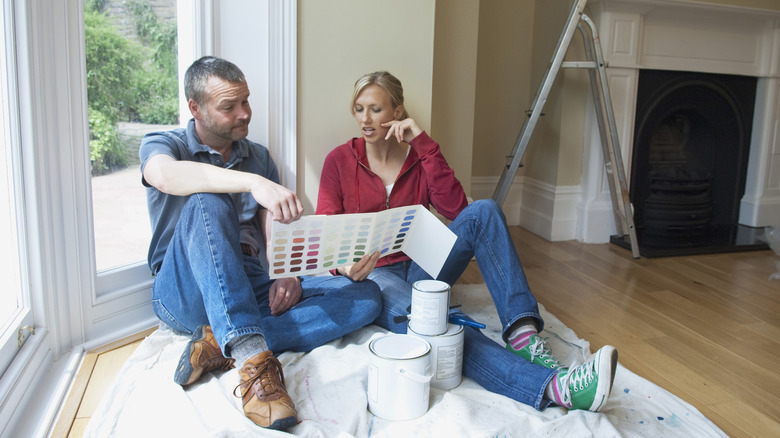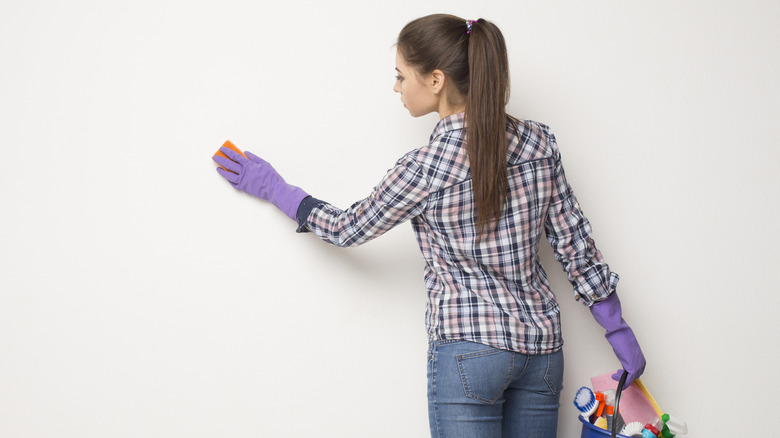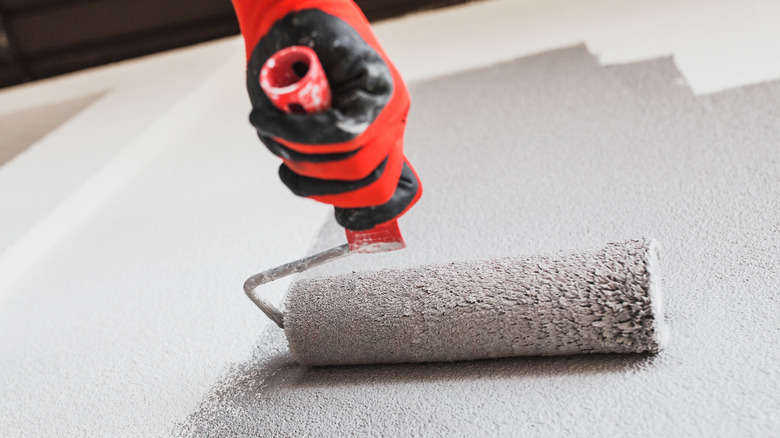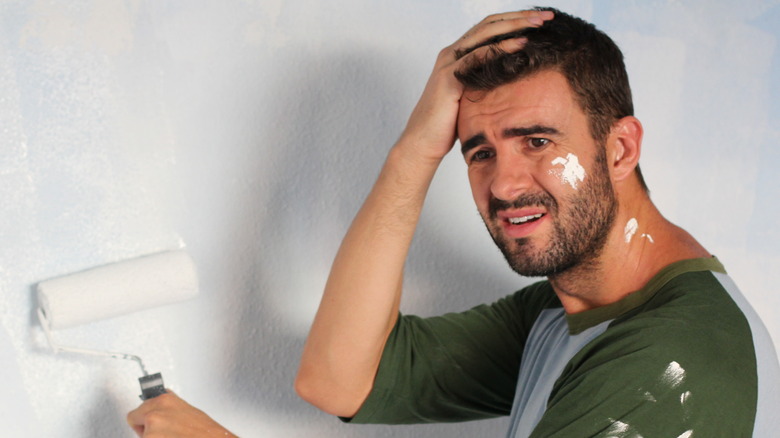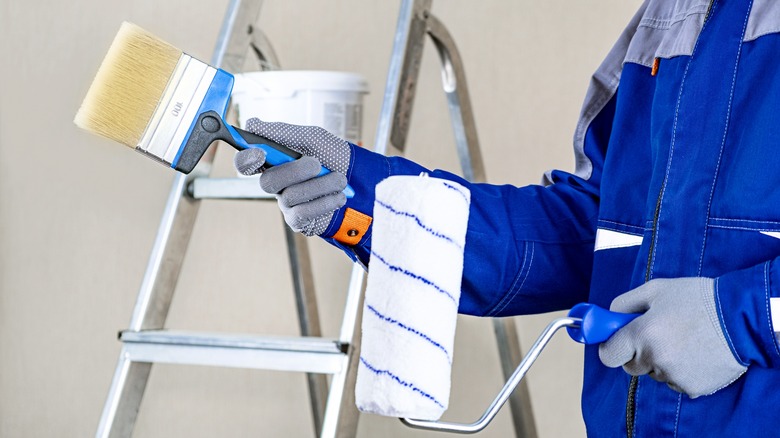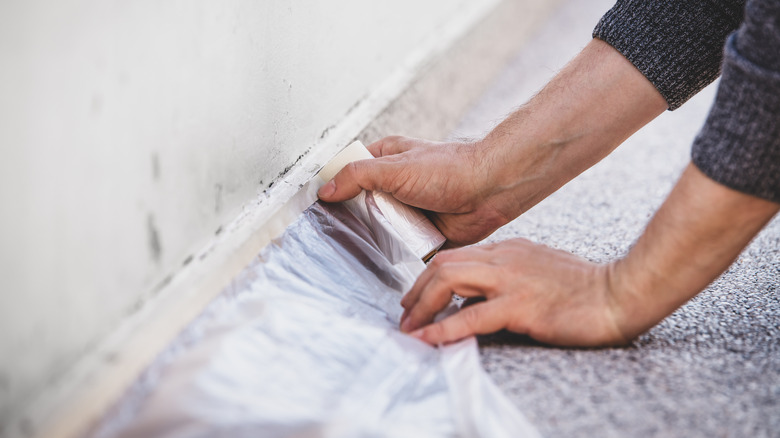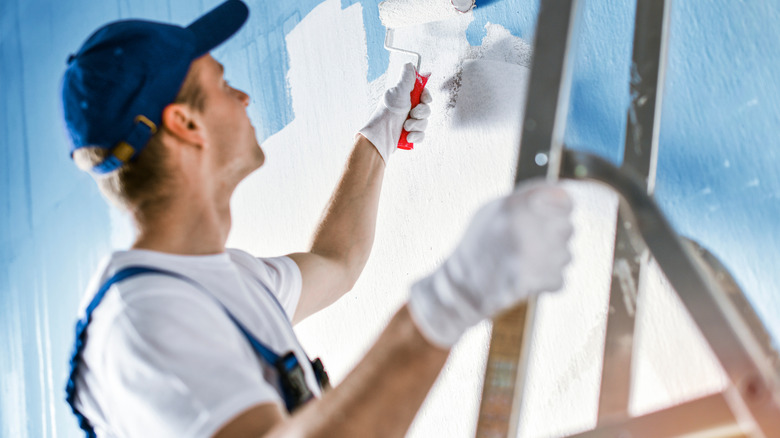An Expert Tells Us The Biggest Painting Mistakes Homeowners Make
Making the decision to paint a room or even the exterior of a house is a big undertaking. Though adding a new coat or two seems rather straightforward, it's often easier to make mistakes than many realize. Did you know the average cost to paint a room ranges from $990 to $1,320 (via Fixr)? Indeed, it's a major home investment that you want to get exactly right. Even if you hire a professional to do the work, it's critical they're the right person for the job. After all, once you paint your home, you don't want to repeat it anytime soon.
Before heading out to purchase a few gallons of paint to get things started, make sure to avoid some common painting mistakes. Jan Walter, a professional painter with more than 25 years of experience, writes about home improvement, renovation, and more at GoColorize, and shares some tips and strategies in an exclusive interview with House Digest.
Not preparing the surface properly
You've purchased the paint necessary for the job and are ready to start coating it on the walls. While it's exciting to see a new color and get a fresh new take on a room, consider pausing and taking a step back. "Prepping the surface before painting is key to a successful paint job," Walter shares. "If the surface is not cleaned properly, the paint will not adhere well and will eventually peel."
Prepping the surface can mean many things, like cleaning it and ensuring the base coat is the proper type to support the new choice. "I've seen paint jobs where they didn't clean or use a primer before painting, resulting in peeling paint. I could even remove the paint with my fingernail," Walter reveals. To that end, investing in the proper primer to put down first and perhaps a few hours of scrubbing surface stains could make a huge difference in the end result, without adding much to the cost or timeline of the project.
Applying too much or too little paint
Of course, when deciding to change the color of any room, the biggest cost is the actual paint. With countless paint brands and types on the market, it's easy to become confused about what to buy. Then, when you get home, you may start to worry about running out of supply and, as such, go easy on the application. "I've seen people try to save money on paint by painting very thin layers, resulting in an uneven finish," Walter shares.
However, you can also make the opposite mistake. "Conversely, I've seen paint jobs where they have applied way too much paint, which resulted in drinks and sags," Walter continued. Applying just the right amount is key, but how best can you determine that? One option is to turn to the manufacturer directly. Read the paint can for a description of how much square footage it will cover and then aim for that within your space. Doing so can help you get just the right level of wall coverage.
Underestimating the level of difficulty
How many home improvement shows have you watched that make painting the walls of a room look so easy? Just dunk your brush in the tray and apply a fresh coat on the wall, right? It's rarely that simple, though. "It looks easy when someone else does it," Walter said. And if you've never previously done the work involved, that may not seem like a valid claim.
In fact, there's often much more to the process than you realize. "But it takes some practice and experience when it comes to cutting in straight lines, taping drywall seams, hanging wallpaper, or skim coating, for example," Walter reveals. The end goal is to create a beautiful, professional look to your walls that becomes the backdrop to your entire interior aesthetic. Investing in this process is only worthwhile when you take your time to ensure it's done well. If you're short on experience, do a bit of practice painting on a blank wall. Or, just hire a professional instead.
Not using proper equipment
Though you don't need a significant number of materials or equipment to paint, there are differences in the quality of products on the market. Put simply, inferior paint produces poor results. "Using low-quality or the wrong type of paintbrushes or rollers is another mistake I've seen homeowners do," Walter said.
Perhaps one of the most confusing decisions is knowing which type of roller to purchase, as there tend to be dozens of options up and down the aisles. "Roller covers with too long nap length result in a finish with too much texture," Walter shares. When it comes to buying paintbrushes, take a closer look at several varieties. "And low-quality paintbrushes result in a finish with brush marks and brush hairs embedded in the paint," he continued.
Additionally, read the instructions for use and make sure any type of roller cover or brush you buy is the right option for the type of paint and surface. If you're unsure, seek out some help and guidance to ensure you get the best possible finish every time.
Not protecting the area around you while painting
The steps you take before painting can be important for what happens after the work is completed. "Another common mistake is that people don't protect the area around them while painting," Walter said. "They don't put down drop cloths, masking paper, painter's tape, or plastic to protect the floors, trim, or furniture from paint drips and spills."
This often leads to splatter marks on surfaces, even across the room. No matter how careful you are, a spill can happen, and removing paint from tile grout or scrubbing furniture shouldn't be the way your project wraps up.
Having a steady hand matters, too. "They also bump the roller into the baseboard or ceiling, leaving paint marks," Walter reveals. With proper masking and taping, though, there's less risk of this happening and creating an unsightly finished project. Now, properly protecting these surfaces no doubt takes a bit more time and money, but not doing so can be costly, especially if stains show up.
Hiring the wrong person
There's no denying the art of painting is hard work, and for many people, that means hiring a professional from the outset. Just be mindful of this process, too. "Finally, the most costly mistake homeowners make is hiring the wrong painting contractor," Walter said. Again, painting isn't easy and takes experience and skill. "They go for the cheapest option, resulting in hiring people with no education or experience," he continued.
Without a doubt, the cost of painting a room surely matters. Yet, the finished work has to be worth it. In other words, selecting the right man or woman for the job is paramount — and that's where many people foul up. "The final result is usually so bad that they have to hire someone else to fix it, which costs them even more money," Walter explains.
You may find the most educated and skilled professionals don't charge exorbitant prices and are worth the investment. More so, when the work is done right, the results are bound to last for years, making it worthwhile to hire a painting professional.
